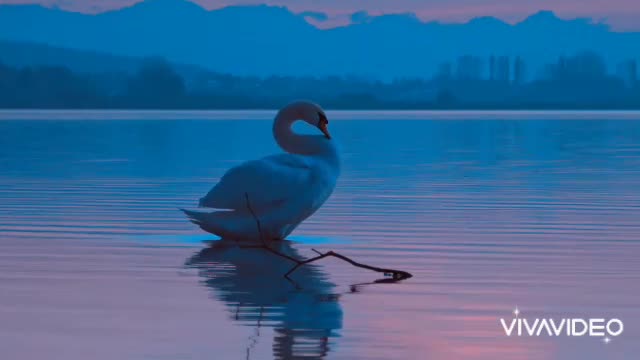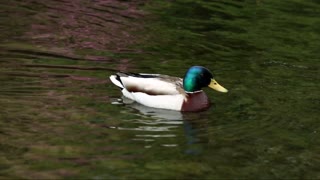Premium Only Content

11 Amazing Facts About Ducks?
Ducks are super cute, but did you know these 11 Amazing Facts About Ducks?
Ducks of the world – Ducks live in both fresh water and sea water and can be found on every continent except for Antarctica
They can sleep with one eye open – Ducks can turn off half their brain while keeping the other half alert for predators. Ducks will usually only fully rest both halves if they are feeling safe & protected either in the middle of a large group of ducks or in a safe location.
Duck Terms – A baby duck is called a duckling, a male is a drake and a female is a hen or duck. A group of ducks is called a raft, a team or a paddling (how cute is that, a paddling of ducks??). Generic “bird” terms can also be used like chick, bird or flock.
Waterproofing – Ducks have highly waterproof feathers thanks to an intricate feather pattern and a wax like coating that they spread onto their feathers while preening. The waxy oil is produced in their preen gland, a small gland at the base of their tail. Duck feathers are so waterproof that they can dive completely underwater and the downy under-feathers will stay totally dry.
No cold feet here – Ducks have a special counter current blood vessel system in their feet/legs so their feet will not feel cold.
Extreme Molting – Most bird species have a “sequential molt” where they lose their flight feathers one at a time, allowing them to always have the ability to fly. This means until they grow back (about 20-40 days) the bird can not fly.
Drake Molting – Drakes will undergo the wing molt we just discussed above, but they also undergo twice yearly molting of their plumage. Shortly after the females make their nest and the main breeding season is over, drakes will molt their colorful plumage. It is replaced with their “eclipse plumage” – drab, brown feathers similar to the female’s coloring. In fall/winter they will molt again, regaining their bright, colorful feathers known as their “nuptial plumage” in preparation for the next mating season.
Mating – Drakes unfortunately have a reputation of very aggressive mating that can sometimes even result in injury or death. In some species of ducks, a female will bond with a male for one season – but she will still be harassed into mating by other males. The female can protect herself from insemination from an unwanted male with a long, complicated oviduct full of twists, turns & chambers. She can sideline sperm & eject it later, so that she only reproduces with the male of her choosing.
Speaking of mating….. Drakes are one of the few bird species that have an external phallus. It is a long, corkscrew shaped tentacle that retracts into their body when not mating – sometimes they can grow to be as long as their entire body! The most bizarre fact of all is that in the fall the phallus completely falls off, only to regrow in the spring. Scientists are unsure why this happens, but think it might be because it is easier to grow a new one rather than keep it healthy. The length it regrows depends on how many rivals males are in their area during mating season. The more rivals, the longer it might grow, to better their chances of offspring.
Ducks can change genders – Gender change in ducks is rare, but happens as often as 1 in every 10,000 birds and can happen both from female to male and male to female, although female to male seems much more common. The cause is undetermined but some think it happens when an imbalance of genders in a flock occurs (a really large all male or all female flock) or due to disease or damage in the reproductive system. When a male bird turns female, it will molt all of it’s colorful plumage, and can develop the louder female quack and display nesting habits. There are stories about a once male duck laying eggs, but I have seen nothing scientifically conclusive. The female to male transformation seems to be studied a bit more. Female ducks that turn male will molt into the colorful male plumage including a drake curl tail feather, and can develop the raspy drake quake & drake mannerisms and could even fertilize eggs! Without getting too technical, a biology based explanation is that almost all birds have two ovaries, but only the left one functions. The right ovary never develops beyond a clump of cells. If the left one becomes damaged, diseased, or for some reason shuts down by an instinct to balance the flock, the female bird is no longer producing oestrogen (the hormone in birds responsible for female characteristics). Sex chromosomes in birds are expressed as Z & W, with all birds “defaulting” to ZZ (male) and the presence of a W chromosome making a female. With no oestrogen being produced, the rudimentary right ovary actually begins to develop into a functioning testis, producing testosterone, leading to the normal male sex traits. click here to read about my female duck that has begun to show male traits
Ducks turn white with age. White ducks are white their whole lives, but dark-colored ducks slowly develop white patches in their feathers as they age, just like humans. Eventually, when they are very old, they could become entirely white.
-
 3:36
3:36
Cat And Dog Tips
4 years ago $0.11 earned5 Amazing Facts About Dogs' Noses
5572 -
 2:32
2:32
Cat And Dog Tips
4 years ago $0.04 earnedAmazing Facts About A Dog's 'Pee-Mail'
4261 -
 0:16
0:16
Funny animals
4 years agoBeautiful and amazing Ducks
59 -
 3:16
3:16
YeMeN Spotlights
4 years ago $0.01 earned7 Facts About Yemen
300 -
 1:32
1:32
NowYouKnowEnglish
4 years agoKnow amazing facts about billion dollar company - Facebook *
50 -
 3:55
3:55
Jimmo4life
4 years ago $0.05 earned10 Facts about French Bulldogs
265 -
 23:00
23:00
Exploring With Nug
15 hours ago $11.94 earnedHis Truck Was Found Crashed in the Woods… But He’s Gone!
68.1K6 -
 27:09
27:09
MYLUNCHBREAK CHANNEL PAGE
15 hours agoDilmun: Where Life Never Ends
60.8K39 -
 2:58:32
2:58:32
Slightly Offensive
8 hours ago $49.33 earnedHas Trump FAILED US? The ABSOLUTE STATE of The Right Wing | Guest: Nick Fuentes
78.4K42 -
 1:37:05
1:37:05
AlaskanBallistics
4 hours ago $0.91 earnedI Love This Gun PodCast #16
18K3